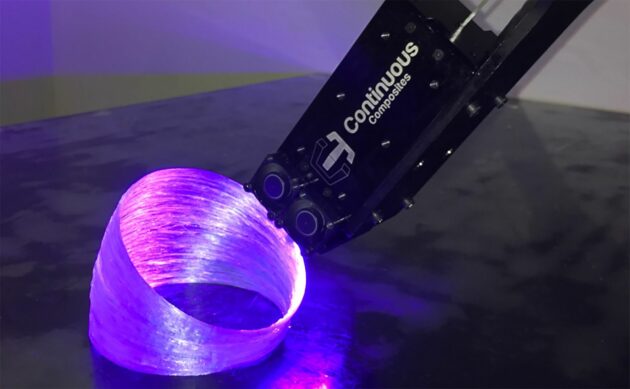
Coeur d’Alene, Id.-based startup Continuous Composites has entered into a joint development agreement with leading French industrial conglomerate Saint-Gobain to develop and bring to market the company’s proprietary form of 3D printing. In addition, Saint-Gobain has made a cash investment in the Idaho startup.
The size of the investment was not disclosed, but the deal has resulted in Continuous Composites becoming a “portfolio company” of Saint-Gobain, said Tyler Alvarado, CEO of Continuous Composites.
Continuous Composites holds patents for the hardware and software that allows what it calls Continuous Fiber 3D Printing, or CF3D. It works by laying down strands of rapid-curing resins that allow for the creation of complex composite structures for the aerospace and automotive industries.
Before COVID-19, there was significant buzz in the aerospace industry about the potential for 3D printing — or “additive manufacturing,” as its proponents call it — to lower the time, cost and amount of waste involved in fabricating lighter-weight aircraft parts.
Traditionally, many key parts have been machined. A company takes a blank piece of metal, and using an expensive machine with a high-skill human operator, cuts away unneeded pieces until only the part is left. The process wastes a lot of material, but results in sturdy parts.
Composite materials — essential high-tech versions of fiberglass — are made the opposite way. Machines or teams of humans take sheets of a carbon-fiber material that have been impregnated with sophisticated resins and build them up one layer at a time. Once the process is done, the piece is put into an autoclave — a high-pressure oven — where it is baked and pressed into a solid.
Composites are lighter and pound-for-pound stronger than metals, which is the primary reason Boeing picked the material for its first 21st century jet, the 787. But the high cost of the labor-intensive process has kept more manufacturers from using composites; today it’s almost exclusively used in aircraft, higher-end cars and top-of-the-line sporting goods, like racing bicycles.

Continuous Composites set out to change that. Its CF3D process lays down a continuous string of carbon fiber material impregnated with fast-drying resins. The resins dry fast enough to eliminate the need for an autoclave, and the tool can be used to make parts in shapes that aren’t feasible to produce through traditional metal-grinding, Alvarado said during a 2019 forum on additive manufacturing applications for aerospace. The company’s process cuts down on the number of steps involved to get from blueprint to finished product and requires less complex tooling, he said.
Alvarado was previously CEO of McAllister Technical Services and was an exec at Woodhawk Manufacturing; both companies are based in Coeur d’Alene, a small city 30 miles east of Spokane, Wash.
Continuous Composites was founded in 2015. Its new partner, however, is one of the oldest companies in Europe. It was founded with the backing of the French crown in 1665 to be the kingdom’s first manufacturer of mirrors, which were then a revolutionary new technology. In 1678 it won the contract to outfit the Hall of Mirrors at the Palace of Versailles. It began producing fiberglass in 1920.
Saint-Gobain’s investment in Continuous Composites came through its NOVA External Venturing unit, which makes investments in startups in advanced materials, construction products or environmental sustainability.



